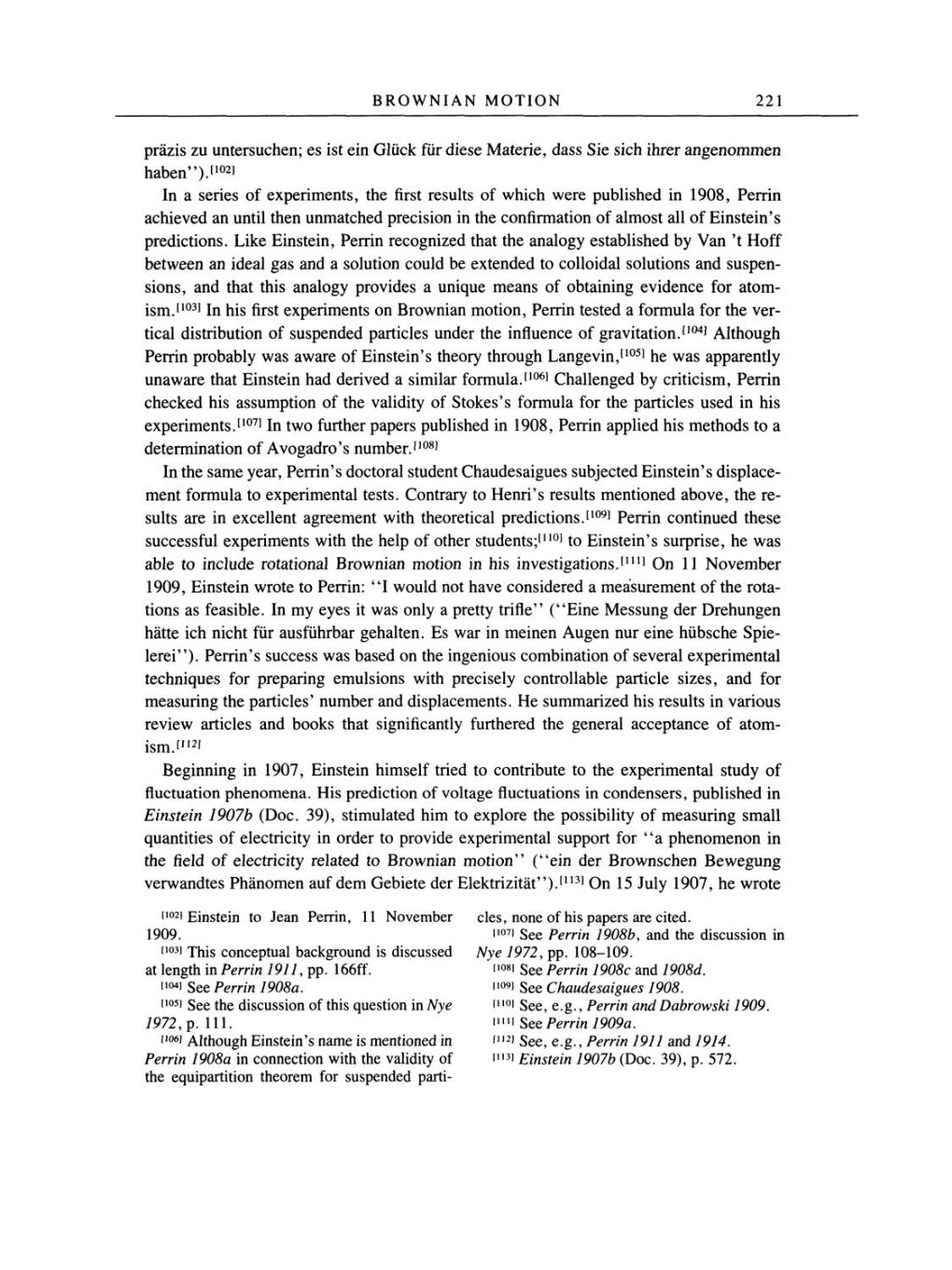BROWNIAN MOTION 221
präzis zu
untersuchen;
es
ist ein Glück für diese Materie, dass Sie sich ihrer
angenommen
haben").[102]
In
a
series
of
experiments,
the first results
of
which
were published
in
1908,
Perrin
achieved
an
until then unmatched
precision
in the confirmation
of
almost all
of Einstein's
predictions.
Like
Einstein,
Perrin
recognized
that the
analogy
established
by Van
't
Hoff
between
an
ideal
gas
and
a
solution could be extended to colloidal solutions and
suspen-
sions,
and that
this
analogy provides
a
unique
means
of
obtaining
evidence
for
atom-
ism.[103]
In his first
experiments on
Brownian
motion,
Perrin tested
a
formula
for
the
ver-
tical distribution
of
suspended particles
under the influence
of
gravitation.[104]
Although
Perrin
probably was aware
of Einstein's
theory through
Langevin,[105]
he
was apparently
unaware
that Einstein had derived
a
similar
formula.[106]
Challenged by
criticism, Perrin
checked his
assumption
of
the
validity
of Stokes's
formula for the
particles
used in his
experiments.[107]
In two further
papers published
in
1908,
Perrin
applied
his methods to
a
determination
of
Avogadro's number.[108]
In the
same year,
Perrin's
doctoral student
Chaudesaigues subjected
Einstein's
displace-
ment formula to
experimental
tests.
Contrary
to
Henri's
results mentioned
above,
the
re-
sults
are
in
excellent
agreement
with theoretical
predictions.[109]
Perrin continued these
successful
experiments
with
the
help
of
other
students;[110]
to
Einstein's
surprise,
he
was
able
to
include rotational Brownian motion in
his
investigations.[111]
On
11
November
1909,
Einstein wrote
to
Perrin:
"I
would not have considered
a
measurement
of
the rota-
tions
as
feasible.
In
my
eyes
it
was
only
a
pretty
trifle"
("Eine
Messung
der
Drehungen
hätte ich nicht für ausführbar
gehalten.
Es
war
in meinen
Augen
nur
eine hübsche
Spie-
lerei").
Perrin's
success was
based
on
the
ingenious
combination
of
several
experimental
techniques
for
preparing
emulsions
with
precisely
controllable
particle sizes,
and for
measuring
the
particles'
number and
displacements.
He summarized his results in
various
review
articles and books that
significantly
furthered the
general acceptance
of
atom-
ism.[112]
Beginning
in
1907,
Einstein
himself
tried to contribute to the
experimental
study
of
fluctuation
phenomena.
His
prediction
of
voltage
fluctuations
in
condensers,
published
in
Einstein 1907b
(Doc. 39),
stimulated him to
explore
the
possibility
of
measuring
small
quantities
of
electricity
in order to
provide experimental support
for
"a
phenomenon
in
the field
of
electricity
related
to
Brownian
motion"
("ein der Brownschen
Bewegung
verwandtes Phänomen
auf
dem Gebiete der
Elektrizität").[113]
On
15 July
1907,
he wrote
[102]
Einstein
to
Jean
Perrin,
11
November
1909.
[103]
This
conceptual background
is
discussed
at
length
in
Perrin
1911,
pp.
166ff.
[104]
See
Perrin
1908a.
[105]
See
the
discussion of this
question
in
Nye
1972,
p.
111.
[106]
Although
Einstein's
name
is
mentioned
in
Perrin
1908a in connection with the
validity
of
the
equipartition
theorem for
suspended parti-
cles,
none
of
his
papers
are
cited.
[107]
See
Perrin
1908b, and
the
discussion in
Nye 1972, pp.
108-109.
[108]
See
Perrin
1908c and 1908d.
[109]
See Chaudesaigues 1908.
[110] See,
e.g.,
Perrin
and Dabrowski 1909.
[111]
See
Perrin
1909a.
[112] See, e.g.,
Perrin
1911 and 1914.
[113]
Einstein
1907b
(Doc. 39),
p.
572.
